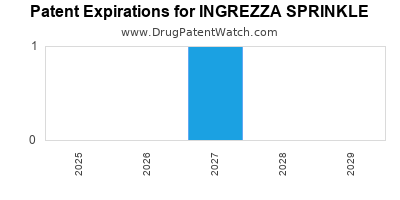INGREZZA SPRINKLE Drug Patent Profile
✉ Email this page to a colleague
Which patents cover Ingrezza Sprinkle, and when can generic versions of Ingrezza Sprinkle launch?
Ingrezza Sprinkle is a drug marketed by Neurocrine and is included in one NDA. There are twenty-two patents protecting this drug and one Paragraph IV challenge.
This drug has two hundred and seventy-two patent family members in thirty-six countries.
The generic ingredient in INGREZZA SPRINKLE is valbenazine tosylate. One supplier is listed for this compound. Additional details are available on the valbenazine tosylate profile page.
DrugPatentWatch® Litigation and Generic Entry Outlook for Ingrezza Sprinkle
A generic version of INGREZZA SPRINKLE was approved as valbenazine tosylate by LUPIN LTD on April 5th, 2024.
AI Deep Research
Questions you can ask:
- What is the 5 year forecast for INGREZZA SPRINKLE?
- What are the global sales for INGREZZA SPRINKLE?
- What is Average Wholesale Price for INGREZZA SPRINKLE?
Summary for INGREZZA SPRINKLE
| International Patents: | 272 |
| US Patents: | 22 |
| Applicants: | 1 |
| NDAs: | 1 |
| Finished Product Suppliers / Packagers: | 1 |
| Patent Litigation and PTAB cases: | See patent lawsuits and PTAB cases for INGREZZA SPRINKLE |
| DailyMed Link: | INGREZZA SPRINKLE at DailyMed |

Pharmacology for INGREZZA SPRINKLE
| Drug Class | Vesicular Monoamine Transporter 2 Inhibitor |
| Mechanism of Action | Vesicular Monoamine Transporter 2 Inhibitors |
Paragraph IV (Patent) Challenges for INGREZZA SPRINKLE
| Tradename | Dosage | Ingredient | Strength | NDA | ANDAs Submitted | Submissiondate |
|---|---|---|---|---|---|---|
| INGREZZA SPRINKLE | Capsules | valbenazine tosylate | 40 mg, 60 mg and 80 mg | 218390 | 1 | 2025-01-07 |
US Patents and Regulatory Information for INGREZZA SPRINKLE
INGREZZA SPRINKLE is protected by thirty-three US patents and one FDA Regulatory Exclusivity.
| Applicant | Tradename | Generic Name | Dosage | NDA | Approval Date | TE | Type | RLD | RS | Patent No. | Patent Expiration | Product | Substance | Delist Req. | Exclusivity Expiration |
|---|---|---|---|---|---|---|---|---|---|---|---|---|---|---|---|
| Neurocrine | INGREZZA SPRINKLE | valbenazine tosylate | CAPSULE;ORAL | 218390-003 | Apr 30, 2024 | RX | Yes | Yes | 10,906,902 | ⤷ Get Started Free | Y | Y | ⤷ Get Started Free | ||
| Neurocrine | INGREZZA SPRINKLE | valbenazine tosylate | CAPSULE;ORAL | 218390-001 | Apr 30, 2024 | RX | Yes | No | 10,919,892 | ⤷ Get Started Free | Y | Y | ⤷ Get Started Free | ||
| Neurocrine | INGREZZA SPRINKLE | valbenazine tosylate | CAPSULE;ORAL | 218390-003 | Apr 30, 2024 | RX | Yes | Yes | 10,857,148 | ⤷ Get Started Free | ⤷ Get Started Free | ||||
| Neurocrine | INGREZZA SPRINKLE | valbenazine tosylate | CAPSULE;ORAL | 218390-002 | Apr 30, 2024 | RX | Yes | No | 10,874,648 | ⤷ Get Started Free | ⤷ Get Started Free | ||||
| >Applicant | >Tradename | >Generic Name | >Dosage | >NDA | >Approval Date | >TE | >Type | >RLD | >RS | >Patent No. | >Patent Expiration | >Product | >Substance | >Delist Req. | >Exclusivity Expiration |
International Patents for INGREZZA SPRINKLE
See the table below for patents covering INGREZZA SPRINKLE around the world.
| Country | Patent Number | Title | Estimated Expiration |
|---|---|---|---|
| Japan | 2021193146 | 特定のVMAT2インヒビターを投与するための方法 (METHODS FOR ADMINISTRATION OF CERTAIN VMAT2 INHIBITORS) | ⤷ Get Started Free |
| Hungary | E065406 | ⤷ Get Started Free | |
| World Intellectual Property Organization (WIPO) | 2017112857 | ⤷ Get Started Free | |
| Serbia | 65154 | ⤷ Get Started Free | |
| >Country | >Patent Number | >Title | >Estimated Expiration |
Market Dynamics and Financial Trajectory for Ingrezza Sprinkle
More… ↓
Make Better Decisions: Try a trial or see plans & pricing
Drugs may be covered by multiple patents or regulatory protections. All trademarks and applicant names are the property of their respective owners or licensors. Although great care is taken in the proper and correct provision of this service, thinkBiotech LLC does not accept any responsibility for possible consequences of errors or omissions in the provided data. The data presented herein is for information purposes only. There is no warranty that the data contained herein is error free. We do not provide individual investment advice. This service is not registered with any financial regulatory agency. The information we publish is educational only and based on our opinions plus our models. By using DrugPatentWatch you acknowledge that we do not provide personalized recommendations or advice. thinkBiotech performs no independent verification of facts as provided by public sources nor are attempts made to provide legal or investing advice. Any reliance on data provided herein is done solely at the discretion of the user. Users of this service are advised to seek professional advice and independent confirmation before considering acting on any of the provided information. thinkBiotech LLC reserves the right to amend, extend or withdraw any part or all of the offered service without notice.
